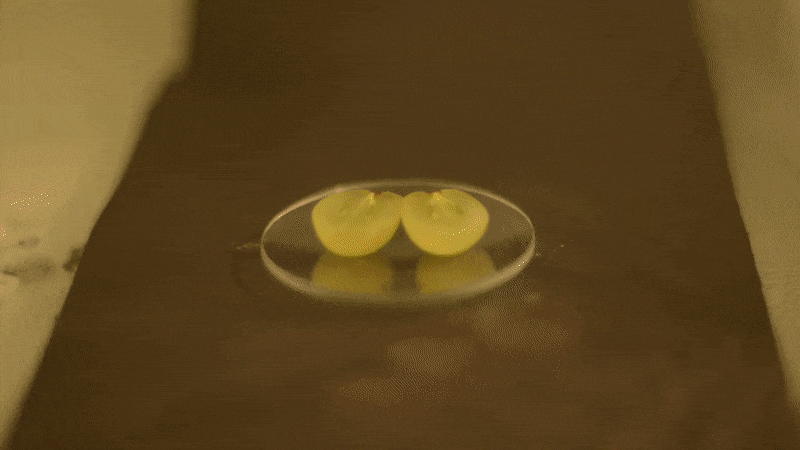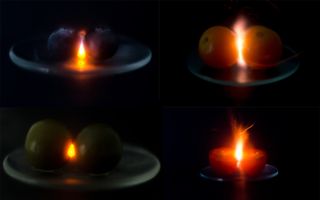Microwaved Grapes Spit Plasma, and Scientists Finally Know Why

If you were to drop a cut grape into the microwave and heat it, something incredible would happen: The little fruit would spit out tiny glowing jets that happen to be a weird state of matter called plasma.
And now, scientists have unraveled the mystery of why grapes ignite in this way: The microwaves create "hotspots" of electromagnetism, a new study revealed.
Viral internet videos have shown this kitchen light show, which occurs when a halved grape (with the halves still connected by skin) gets blasted with radiation in a microwave. Tiny fountains of brilliant plasma — gas charged with ions — crackle from the spot where the grape halves connect. It's an astonishing sight, but even though videos showing this phenomenon have existed for more than two decades, scientists didn't know why such grape pyrotechnics happened. [The 18 Biggest Unsolved Mysteries in Physics]
To get to the bottom of the mechanics, Pablo Bianucci, an associate professor in the Department of Physics at Concordia University in Montreal, and colleagues recently filmed a variety of grapes, hydrogel beads and water-filled quail eggs using high-speed cameras shooting 1,000 frames per second. The researchers used household microwaves with disabled turntables, operating at 2.4 gigahertz; the researchers also modified a microwave so they could capture thermal imaging, using a special door that was mostly transparent to the wavelengths seen by a thermal camera.
Results showed that a microwaved grape's size and composition — particularly the amount of water it contains — determine the fruit's ability to light up, Bianucci told Live Science in an email.
Here's why: Size and water content affect how grapes — or other small spheres, such as beads, berries, grape tomatoes or olives — interact with microwave radiation, Bianucci explained.
"There is a lucky coincidence in the fact that the grapes have both the right composition (mostly water) and size" so that a single wavelength of microwave radiation fits almost entirely into the grape, meaning the grape can "trap" microwaves, he said.
Sign up for the Live Science daily newsletter now
Get the world’s most fascinating discoveries delivered straight to your inbox.
When two connected halves of a grape are bombarded with radiation, microwaves that become trapped in the tissues of each half can use the connecting skin as a bridge, "hopping" from one grape hemisphere to the other, according to Bianucci.
"This results in a 'hotspot' with a much stronger electromagnetic field in between the grapes," he said. "It is this strongly amplified field that results in the generation of the plasma."

Prior to the researchers' experiments, it was widely thought that microwaved grapes produced plasma through surface conductivity, with the ion-rich flap of skin connecting the grape halves transmitting an electrical current that generated the plasma. While this was a plausible explanation, it had never been verified in a peer-reviewed study, and that prompted study co-author Aaron Slepkov, an associate professor in the Department of Physics and Astronomy at Trent University in Ontario, Canada, to put grapes into microwaves for science.
The team discovered that irradiated objects produced plasma even when the objects were whole and there was no skin "bridge," as long as there was physical contact between the two halves. Even whole grapes would produce plasma about 60 percent of the time — if they were touching another grape.
However, single, undivided grapes wouldn't spark at all, the researchers reported.
The findings were published online Feb. 18 in the journal Proceedings of the National Academy of Sciences.
- States of Matter: Plasma
- Science Fact or Fiction? The Plausibility of 10 Sci-Fi Concepts
- Cotton Candy Grapes: The science behind the sweet, carnival taste
Originally published on Live Science.

Mindy Weisberger is an editor at Scholastic and a former Live Science channel editor and senior writer. She has reported on general science, covering climate change, paleontology, biology, and space. Mindy studied film at Columbia University; prior to Live Science she produced, wrote and directed media for the American Museum of Natural History in New York City. Her videos about dinosaurs, astrophysics, biodiversity and evolution appear in museums and science centers worldwide, earning awards such as the CINE Golden Eagle and the Communicator Award of Excellence. Her writing has also appeared in Scientific American, The Washington Post and How It Works Magazine.
Most Popular


